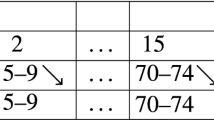Abstract
Dual-record system methods are commonly used as a basis for population estimation. A basic assumption is that the units sampled are drawn only from the population to be estimated. This assumption cannot be met for remote Indigenous communities in Australia. A new variant of dual-record population estimation is presented, which relies on the availability of specific additional information to relax the assumption of perfect frame specification. This variant is applied to two remote Indigenous communities in the Northern Territory of Australia, using locally available data sources. Further theoretical exploration of this method is presented along with possible applications in estimating area-enumerated populations and census coverage.
Similar content being viewed by others

References
Australian Bureau of Statistics (ABS). 2002.2001 Census First Release Indigenous Profiles. <http://www.abs.gov.au/>. Canberra: Date accessed: 31 July 2004.
Australian Bureau of Statistics (ABS). 2003.Information Paper: Census of Population and Housing: Data Quality — Undercount, Australia 2001. Canberra.
Australian Bureau of Statistics (ABS). 2004,Regional Population Growth: Australian and New Zealand 2002–3. Canberra.
Brenner, H. 1996. Effects of misdiagnoses on disease monitoring with capture-recapture methods.Journal of Clinical Epidemiology 49(11): 1303–1307.
Chandrasekar, C. and W.E. Deming. 1949. On a method of estimating birth and death rates and the extent of registration.Journal of the American Statistical Association 44: 101–115.
Department of Lands, Planning and the Environment. 2000.Serviced Land Availability Plans. Darwin.
Kerr, D. 1998.A Review of Procedures for Estimating the Net Undercount of Censuses in Canada, the United States, Britain and Australia. Ottawa: Statistics Canada.
Kerry, S.M. and J.M. Bland. 1998. The intracluster correlation coefficient in cluster randomisation.British Medical Journal 316: 1455–1460.
Kerry, S.M. and J.M. Bland. 2001. Unequal cluster sizes for trials in English and Welsh general practice: implications for sample size calculations.Statistics in Medicine 20: 377–390.
Landis, J.R. and G.G. Koch. 1977. The measurement of observer agreement for categorical data.Biometrics 33(1): 159–174.
Larson A., A. Stevens and G. Wardlaw. 1994. Indirect estimates of hidden populations: capture-recapture methods to estimate the numbers of heroin users in the Australian Capital Territory.Social Science and Medicine 39(6): 823–831.
Le Cren, E.D. 1965. A note on the history of mark-recapture population estimates.Journal of Animal Ecology 34: 453–454.
Martin, D.F., F. Morphy, W.G. Sanders and J. Taylor. 2003.Making Sense of the Census: Observations of the 2001 Enumeration in Remote Aboriginal Australia. Research Monograph 22. Canberra: Centre for Aboriginal Economic Policy Research.
NTGrants Commission. 2000.Annual Report 1999/2000. <http://www.dcdsca.nt.gov.au/dcdsca/intranet.nsf/pages/NTGC_Publications>. Darwin: Northern Territory Government. Date accessed: 31 July 2004.
Shapiro, S. 1949. Estimating birth registration completeness.Journal of the American Statistical Association 45: 261–264.
Statistics Canada. 2002.2001 Census Technical Report. Census Reference Series. Catalogue No. 92-394-XIE. Ottawa.
Taylor, J. 1998. Measuring short-term population mobility among indigenous Australians: options and implications.Australian Geographer 29(1): 125–137.
Taylor, J. and M. Bell. 1996. Population mobility and Indigenous peoples: the view from Australia.International Journal of Population Geography 2(2): 153–171.
Taylor, J. and M. Bell (eds.). 2004.Population Mobility and Indigenous Peoples in Australasia and North America. Routledge Research in Population and Migration. London: Routledge.
Thurston, S.W. and A.M. Zaslavsky. 1994. Using ethnographic data to evaluate dual system estimates.Proceedings of the Survey Research Methods Section. American Statistical Association: 254–259. <http://www.amstat.org/sections/srms/Proceedings/>. Date accessed: 4 January 2006.
Warchivker, I., T. Tjapangati and J. Wakerman. 2000. The turmoil of Aboriginal enumeration: mobility and service population analysis in a Central Australian community.Australian and New Zealand Journal of Public Health 24(4): 444–448.
Yukiko E. 1995. Examination of census omission and erroneous enumeration based on 1990 ethnographic studies of census coverage.Proceedings of the Survey Research Methods Section. American Statistical Association: 515–520. <http://www.amstat.org/sections/srms/Proceedings/>. Date accessed: 4 January 2006.
Author information
Authors and Affiliations
Corresponding author
Rights and permissions
About this article
Cite this article
Paradies, Y., Barnes, T. A new variant of dual-record population estimation with an application in remote indigenous communities. Journal of Population Research 22, 119–139 (2005). https://doi.org/10.1007/BF03031825
Issue Date:
DOI: https://doi.org/10.1007/BF03031825



